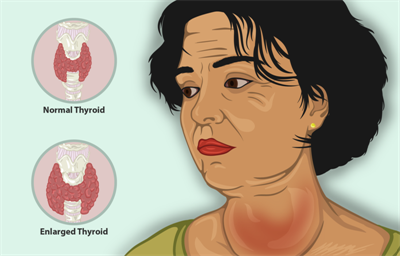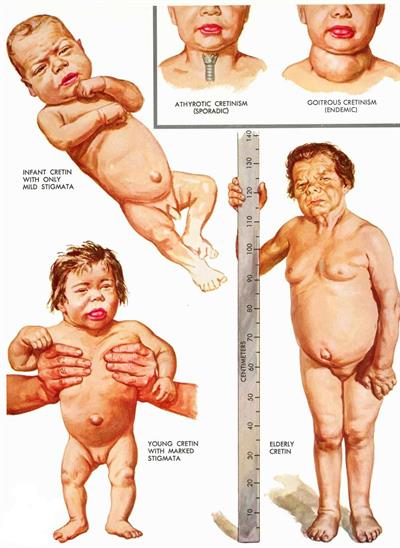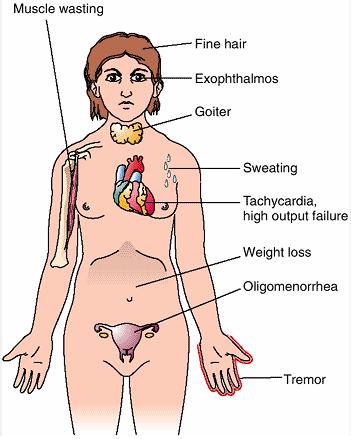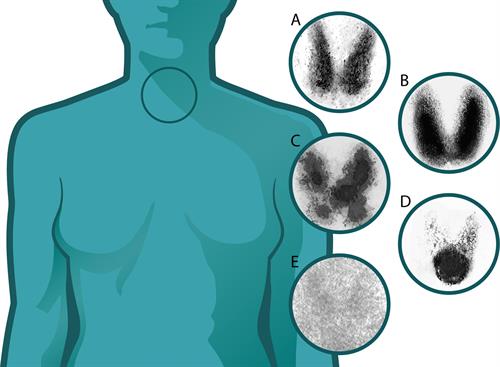PDF chapter test TRY NOW
When the thyroid gland fails to secrete normal levels of thyroid hormones, the condition is called thyroid dysfunction. It leads to the following disorders:
I. Hypothyroidism:
Hypothyroidism is caused due to the decreased secretion or deficiency of the thyroid hormones. The abnormal conditions are simple goitre, cretinism and myxoedema.
1. Goitre:
It is caused due to an insufficient supply of iodine in our diet. Goitre is prevalent in the hilly areas like Himalayan regions as the iodine content in the soil is low. It leads to thyroid gland enlargement, which protrudes as a swelling in the neck called goitre. The addition of iodine to the table salt prevents the disease.

Women having goitre
2. Cretinism:
Cretinism is caused due to a decreased secretion of thyroid hormones in children. The disease causes:
- Stunted growth
- Mental defects
- Lack of skeletal development
- Pot-belly, and
- Malformed bones
They are called cretins. An early administration of thyroid hormones can treat the disease.

Cretinism
3. Myxoedema:
Myxoedema is caused due to the deficiency of thyroid hormones in adults. It is also called as Gull's disease. The disease is characterised by:
- Puffiness observed in the face and hands due to the accumulation of fat in the subcutaneous tissue.
- Patients lack alertness and are mentally sluggish.
- Have increased body weight.
- Have oedematous appearance.
The disease can be treated by administration of the thyroid hormones.

A man with Myxoedema
II. Hyperthyroidism:
Hyperthyroidism is caused due to the excessive secretion of thyroid hormones which leads to Grave's disease. It is also known as Basedow's disease or Parry's disease. The symptoms of the disease include:
- Protrusion of the eyeballs called exophthalmia. It is caused due to fluid accumulation behind the eyes.
- Accelerated metabolic rate.
- Elevated body temperature.
- Profuse sweating.
- Loss of weight
- Nervousness
- Excitability and restlessness.

Symptoms of Grave's disease
Comparison between the healthy thyroid gland with different syndromes:

Thyroid scintigraphy - radioactive image of internal organs
A. Normal thyroid
B. Grave's disease
C. Plummer's disease
D. Toxic adenoma
E. Thyroiditis
Reference:
https://commons.wikimedia.org/wiki/File:A_woman_suffering_from_Goiter.png
https://www.flickr.com/photos/51234202@N06/4713284038/in/photolist-8buP8U-T1EFzQ-awgsPx-7qejP6-arUxXt-2hgGj4B-nhJUNY-wsqpL3-o7zxL2-2j4sw8j-MDc6xr-7qejU4-7qifrJ-7qekfB-7qifuA-7qifjA-7qifxS-aeQUWC-7qifoh-7qejLe-o7hbnF-o7sptJ-o9mDeZ-c5SxjN-o9mBjM-2kALrFe-o7snLf-2kALrPa-2kALrPR-5xuHUM-2kALrU5-2kAQBM7-2kALrRV-2iTjvoj-bti4wH-2kAPZpw-o9mBn2-8a8woy-pobqwn-o7D6uX-23U4ain-7QnFbq-m2YCTL-6oTyka-rwYyUg-rfCEyB-rfCDR4-5Fmq1j-5FmrP3-2jtdcKG
https://commons.wikimedia.org/wiki/File:Myxedema_standing.png
https://commons.wikimedia.org/wiki/File:HyperaldosteronismSymptoms.jpeg
https://commons.wikimedia.org/wiki/File:Thyroid_scintigraphy.jpg
